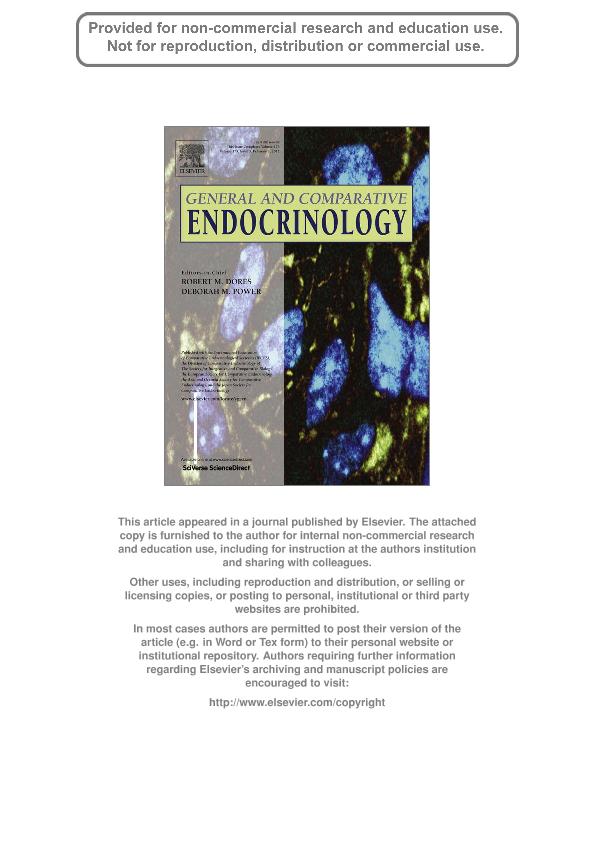Mostrar el registro sencillo del ítem
dc.contributor.author
Palacios, María Gabriela

dc.contributor.author
Sparkman, Amanda M.
dc.contributor.author
Bronikowski, Anne M.
dc.date.available
2019-02-21T20:24:42Z
dc.date.issued
2012-02
dc.identifier.citation
Palacios, María Gabriela; Sparkman, Amanda M.; Bronikowski, Anne M.; Corticosterone and pace of life in two life-history ecotypes of the garter snake thamnophis elegans; Academic Press Inc Elsevier Science; General and Comparative Endocrinology; 175; 3; 2-2012; 443-448
dc.identifier.issn
0016-6480
dc.identifier.uri
http://hdl.handle.net/11336/70658
dc.description.abstract
Glucocorticoids are main candidates for mediating life-history trade-offs by regulating the balance between current reproduction and survival. It has been proposed that slow-living organisms should show higher stress-induced glucocorticoid levels that favor self-maintenance rather than current reproduction when compared to fast-living organisms. We tested this hypothesis in replicate populations of two ecotypes of the garter snake (Thamnophis elegans) that exhibit slow and fast pace of life strategies. We subjected free-ranging snakes to a capture-restraint protocol and compared the stress-induced corticosterone levels between slow- and fast-living snakes. We also used a five-year dataset to assess whether baseline corticosterone levels followed the same pattern as stress-induced levels in relation to pace of life. In accordance with the hypothesis, slow-living snakes showed higher stress-induced corticosterone levels than fast-living snakes. Baseline corticosterone levels showed a similar pattern with ecotype, although differences depended on the year of study. Overall, however, levels of glucocorticoids are higher in slow-living than fast-living snakes, which should favor self-maintenance and survival at the expense of current reproduction. The results of the present study are the first to relate glucocorticoid levels and pace of life in a reptilian system and contribute to our understanding of the physiological mechanisms involved in life-history evolution.
dc.format
application/pdf
dc.language.iso
eng
dc.publisher
Academic Press Inc Elsevier Science

dc.rights
info:eu-repo/semantics/openAccess
dc.rights.uri
https://creativecommons.org/licenses/by-nc-sa/2.5/ar/
dc.subject
Corticosterone
dc.subject
Life-History
dc.subject
Physiological Mechanism
dc.subject
Reptile
dc.subject
Stress
dc.subject
Trade-Off
dc.subject.classification
Otras Ciencias Biológicas

dc.subject.classification
Ciencias Biológicas

dc.subject.classification
CIENCIAS NATURALES Y EXACTAS

dc.title
Corticosterone and pace of life in two life-history ecotypes of the garter snake thamnophis elegans
dc.type
info:eu-repo/semantics/article
dc.type
info:ar-repo/semantics/artículo
dc.type
info:eu-repo/semantics/publishedVersion
dc.date.updated
2019-01-14T13:28:18Z
dc.journal.volume
175
dc.journal.number
3
dc.journal.pagination
443-448
dc.journal.pais
Estados Unidos

dc.description.fil
Fil: Palacios, María Gabriela. Consejo Nacional de Investigaciones Científicas y Técnicas. Centro Científico Tecnológico Conicet - Centro Nacional Patagónico; Argentina. University of Iowa; Estados Unidos
dc.description.fil
Fil: Sparkman, Amanda M.. University of Iowa; Estados Unidos
dc.description.fil
Fil: Bronikowski, Anne M.. University of Iowa; Estados Unidos
dc.journal.title
General and Comparative Endocrinology

dc.relation.alternativeid
info:eu-repo/semantics/altIdentifier/url/https://www.sciencedirect.com/science/article/pii/S0016648011004564?via%3Dihub
dc.relation.alternativeid
info:eu-repo/semantics/altIdentifier/doi/https://doi.org/10.1016/j.ygcen.2011.11.042
Archivos asociados
